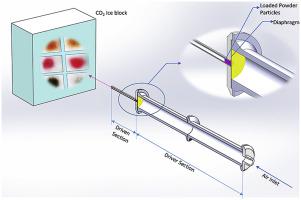当前位置:
X-MOL 学术
›
Planet. Space Sci.
›
论文详情
Our official English website, www.x-mol.net, welcomes your
feedback! (Note: you will need to create a separate account there.)
Sticking of dust/ micrometeorite particles on to ices at high impact velocities - Implications for astrochemical ice enrichment
Planetary and Space Science ( IF 1.8 ) Pub Date : 2020-10-01 , DOI: 10.1016/j.pss.2020.104972 E. Shivakarthik , J.K. Meka , Harish , V.S. Surendra , K.K. Rahul , R. Thombre , H. Hill , S. Vijayan , B. Sivaraman
Planetary and Space Science ( IF 1.8 ) Pub Date : 2020-10-01 , DOI: 10.1016/j.pss.2020.104972 E. Shivakarthik , J.K. Meka , Harish , V.S. Surendra , K.K. Rahul , R. Thombre , H. Hill , S. Vijayan , B. Sivaraman

|
Abstract Impact events are inevitable to date both within the inner and outer regions of the Solar System. Such impact events dominate the surface modifications of most of the airless bodies. Regardless of the destructive nature of impact events, the birth of few moons in the Solar System are known to be the by-products of impacts. Moreover, particle aggregation from relatively low velocity impacts (from nm to μm sized dust particles) are thought to be the reason behind the growth of planetesimals. While considering impact events in the colder regions of the Solar System the role of molecular ices in planetesimal aggregation cannot be neglected. Therefore, to understand the role of such small particle impacts over icy bodies, we investigated the sticking of dust particles on to ices in the higher velocity impact regime, 100–300 m s−1, using a modified hand driven shock tube (Reddy Tube). Grains of brick, basalt and powdered turmeric, graphite and fullerene soot particles were fired on to the CO2 ice targets. Meteorite samples (Sulagiri and Allende) were used to mimic the real micrometeorite impacts on to dry ice. The particles of different sizes and impact angle are found to significantly affect the sticking pattern. The impact area was observed to be coated by the impacting material. Lesser micron sized particles were observed to penetrate into the ice layers and the larger ones eroding them. Results suggest that astrochemical ices can be chemically enriched by high velocity dust/micrometeoroid impacts.
中文翻译:

灰尘/微陨石颗粒以高冲击速度粘附在冰上——对天体化学冰富集的影响
摘要 迄今为止,无论是在太阳系内部还是外部区域,撞击事件都是不可避免的。这种撞击事件主导了大多数无气物体的表面改性。不管撞击事件的破坏性如何,众所周知,太阳系中少数卫星的诞生是撞击的副产品。此外,来自相对低速撞击的粒子聚集(从纳米到微米大小的尘埃粒子)被认为是小行星生长背后的原因。在考虑太阳系较冷地区的撞击事件时,不能忽视分子冰在微行星聚集中的作用。因此,为了了解这种小颗粒撞击冰体的作用,我们研究了尘埃颗粒在更高速度撞击范围内(100-300 m s-1)粘附在冰上的情况,使用改进的手动冲击管(Reddy Tube)。砖粒、玄武岩和姜黄粉、石墨和富勒烯烟灰颗粒被发射到二氧化碳冰靶上。陨石样本(Sulagiri 和 Allende)被用来模拟真实的微陨石撞击干冰。发现不同尺寸和冲击角度的颗粒显着影响粘附模式。观察到冲击区域被冲击材料覆盖。观察到较小微米尺寸的颗粒渗入冰层,较大的颗粒侵蚀它们。结果表明,高速尘埃/微流星体撞击可以使天体化学冰在化学上富集。陨石样本(Sulagiri 和 Allende)被用来模拟真实的微陨石撞击干冰。发现不同尺寸和冲击角度的颗粒显着影响粘附模式。观察到撞击区域被撞击材料覆盖。观察到较小微米尺寸的颗粒渗入冰层,较大的颗粒侵蚀它们。结果表明,高速尘埃/微流星体撞击可以使天体化学冰在化学上富集。陨石样本(Sulagiri 和 Allende)被用来模拟真实的微陨石撞击干冰。发现不同尺寸和冲击角度的颗粒显着影响粘附模式。观察到冲击区域被冲击材料覆盖。观察到较小微米尺寸的颗粒渗入冰层,较大的颗粒侵蚀它们。结果表明,高速尘埃/微流星体撞击可以使天体化学冰在化学上富集。观察到较小微米尺寸的颗粒渗入冰层,较大的颗粒侵蚀它们。结果表明,高速尘埃/微流星体撞击可以使天体化学冰在化学上富集。观察到较小微米尺寸的颗粒渗入冰层,较大的颗粒侵蚀它们。结果表明,高速尘埃/微流星体撞击可以使天体化学冰在化学上富集。
更新日期:2020-10-01
中文翻译:

灰尘/微陨石颗粒以高冲击速度粘附在冰上——对天体化学冰富集的影响
摘要 迄今为止,无论是在太阳系内部还是外部区域,撞击事件都是不可避免的。这种撞击事件主导了大多数无气物体的表面改性。不管撞击事件的破坏性如何,众所周知,太阳系中少数卫星的诞生是撞击的副产品。此外,来自相对低速撞击的粒子聚集(从纳米到微米大小的尘埃粒子)被认为是小行星生长背后的原因。在考虑太阳系较冷地区的撞击事件时,不能忽视分子冰在微行星聚集中的作用。因此,为了了解这种小颗粒撞击冰体的作用,我们研究了尘埃颗粒在更高速度撞击范围内(100-300 m s-1)粘附在冰上的情况,使用改进的手动冲击管(Reddy Tube)。砖粒、玄武岩和姜黄粉、石墨和富勒烯烟灰颗粒被发射到二氧化碳冰靶上。陨石样本(Sulagiri 和 Allende)被用来模拟真实的微陨石撞击干冰。发现不同尺寸和冲击角度的颗粒显着影响粘附模式。观察到冲击区域被冲击材料覆盖。观察到较小微米尺寸的颗粒渗入冰层,较大的颗粒侵蚀它们。结果表明,高速尘埃/微流星体撞击可以使天体化学冰在化学上富集。陨石样本(Sulagiri 和 Allende)被用来模拟真实的微陨石撞击干冰。发现不同尺寸和冲击角度的颗粒显着影响粘附模式。观察到撞击区域被撞击材料覆盖。观察到较小微米尺寸的颗粒渗入冰层,较大的颗粒侵蚀它们。结果表明,高速尘埃/微流星体撞击可以使天体化学冰在化学上富集。陨石样本(Sulagiri 和 Allende)被用来模拟真实的微陨石撞击干冰。发现不同尺寸和冲击角度的颗粒显着影响粘附模式。观察到冲击区域被冲击材料覆盖。观察到较小微米尺寸的颗粒渗入冰层,较大的颗粒侵蚀它们。结果表明,高速尘埃/微流星体撞击可以使天体化学冰在化学上富集。观察到较小微米尺寸的颗粒渗入冰层,较大的颗粒侵蚀它们。结果表明,高速尘埃/微流星体撞击可以使天体化学冰在化学上富集。观察到较小微米尺寸的颗粒渗入冰层,较大的颗粒侵蚀它们。结果表明,高速尘埃/微流星体撞击可以使天体化学冰在化学上富集。











































 京公网安备 11010802027423号
京公网安备 11010802027423号